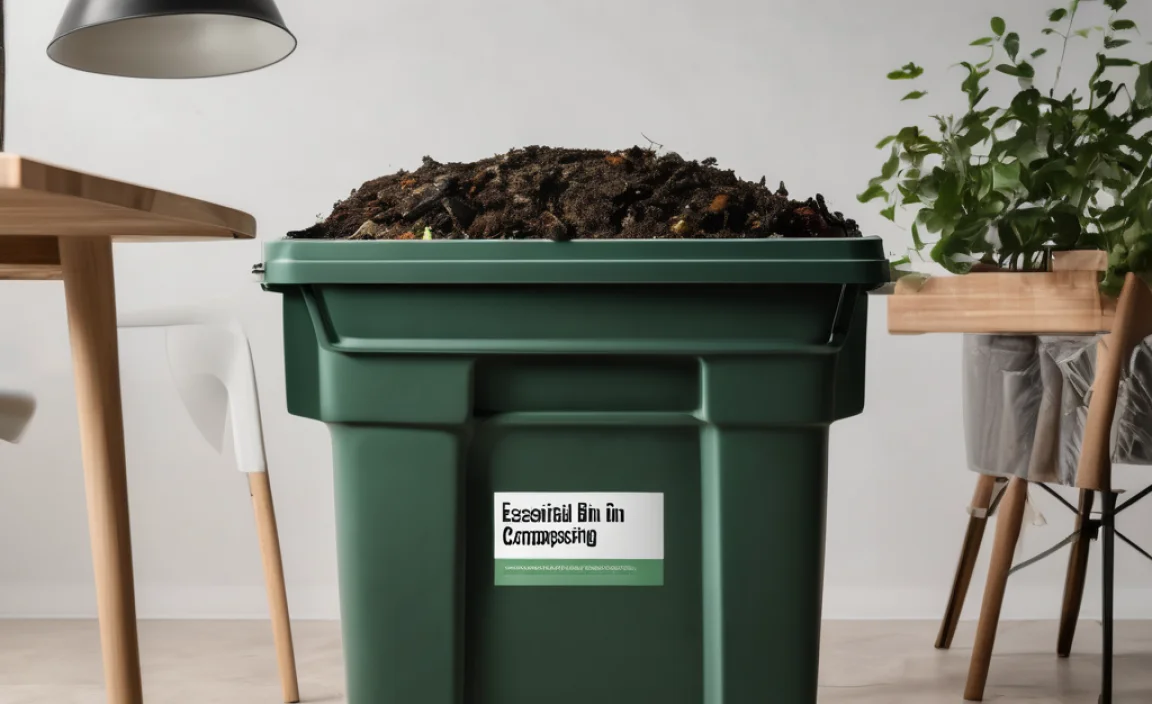Have you ever wondered what happens to fruit peels or wilted lettuce? Instead of throwing them away, you can turn them into something useful. It’s called composting! Making compost is like creating magic soil for plants. A compost bin helps you do this at home. This guide will show you how to start a compost bin. Let’s learn how it benefits both us and the planet!
Key Takeaways
- Compost bins turn waste into rich plant food.
- You can compost fruits, vegetables, and leaves.
- A compost bin guide helps beginners start easily.
- Proper composting reduces trash and helps the earth.
- Composting can be fun and educational for kids.
Understanding A Compost Bin
A compost bin is a container where you put organic waste. With time, it changes into nutrient-rich humus. Composting helps plants grow better. It also reduces waste in landfills. Many types of bins are made from wood, plastic, or metal. They vary in size depending on your needs. Whether you have a big garden or just a small balcony, there’s a bin for you. Using a compost bin is easy once you know the basics.
- Compost bins come in various shapes and sizes.
- Most bins have a lid to keep pests away.
- Bins should allow air to flow through them.
- Place your bin in a dry and shady spot.
- Bins need to be monitored regularly for moisture.
Choosing the right compost bin depends on your space and needs. Some people prefer simple open heaps, while others like tumblers. Tumblers are bins that you can turn easily. This helps in mixing the compost materials. Remember, a good bin keeps the process neat and tidy. It’s also great for learning about nature and recycling.
Fun Fact or Stats : About 20% of household waste is compostable!
Types Of Compost Bins
Did you know there are different types of compost bins? Some are made for small spaces like apartments. Others are big for gardens. The most common types are stationary bins, tumblers, and vermicomposters. Stationary bins stay in one place. Tumblers can be rolled or turned. Vermicomposters use worms to break down waste. Each type has its own benefits, so consider what works best for you. Do you have a small yard or just a balcony?
Benefits Of A Compost Bin
Why use a compost bin? It’s good for the earth! Composting reduces trash going to landfills. It turns waste into useful soil for plants. Plants grow faster and healthier with compost. It saves money on fertilisers too. Children can learn the importance of recycling and nature. Doesn’t it feel great to help the planet while making less trash?
Where To Place Your Compost Bin
Finding the right spot for your compost bin is crucial. Should it be sunny or shady? Most bins work best in a dry, shady place. Avoid direct sunlight, as it can dry out the compost. Make sure the area is easy to reach. You’ll need to add materials and check on your compost regularly. A convenient spot makes composting hassle-free. Also, keeping your bin away from windy areas is a smart move.
Materials To Compost In Your Bin
Not all waste can go into a compost bin. It’s important to know what materials are compostable. You can compost fruit and vegetable scraps, coffee grounds, and eggshells. Leaves and grass clippings are also great. Avoid meat, dairy, and oily foods. These items can attract pests and smell bad. Did you know paper towels and napkins can also be composted? Make sure they’re unbleached and free from chemicals.
How To Maintain Your Compost Bin
Maintaining your compost bin is simple. First, always balance “greens” and “browns.” Greens are wet materials like food scraps. Browns are dry items like leaves. Mix them well for best results. Check the bin’s moisture; it should feel like a damp sponge. Too dry? Add water. Too wet? Add more browns. Aerating or turning your compost helps it break down faster. Keep pests away by burying food scraps under other materials.
Conclusion
Starting a compost bin is an exciting journey. Our compost bin guide makes it simple for everyone. Turning waste into gold for gardens is fulfilling. You can reduce waste and help plants grow better. Remember, every small effort counts towards a healthier planet. Let’s all compost and make the earth a greener place!
FAQs
Question: What is composting?
Answer: Composting is the process of recycling organic waste into nutrient-rich soil. It helps reduce trash and provides food for plants. Using a compost bin guide makes it easy, fun, and beneficial for the environment.
Question: What can I compost?
Answer: You can compost fruits, vegetables, coffee grounds, eggshells, and plant trimmings. Avoid meat, dairy, and oily foods as they attract pests. Paper towels and napkins are also compostable if they are clean and free from chemicals.
Question: How long does composting take?
Answer: Composting can take anywhere from a few months to a year. The time depends on the materials and how well you maintain the compost bin. Regular mixing and proper moisture speed up the process, resulting in quicker compost.
Question: Where should I put my compost bin?
Answer: Place your compost bin in a dry and shady spot. Avoid direct sunlight to prevent drying out. Make sure the location is convenient for regular visits. Keeping it away from strong winds will help maintain moisture levels.
Question: Do I need special tools for composting?
Answer: You don’t need many tools for composting. A simple pitchfork or shovel is useful for turning the compost. A thermometer helps monitor temperature, and a spray bottle can add moisture when needed.
Question: Why follow a compost bin guide?
Answer: A compost bin guide provides step-by-step instructions for beginners. It explains what to compost, where to place your bin, and how to maintain it. Following a guide ensures successful composting and a positive impact on the environment.

